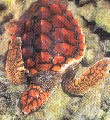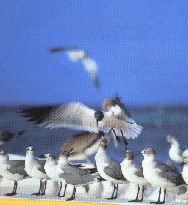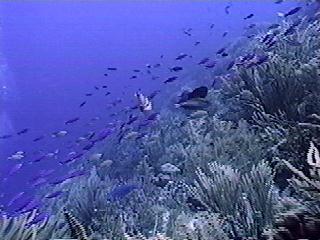|
Sail aboard the SOLITUDE in a Paradise of white sands and crystal waters. We offer VIP Service for two (2) couples aboard our cruising
yacht CSY (Caribbean Sailing Yacht) “Solitude” of 44 ft., cruise in the Archipelago of Los roques staying in spacious cabins with private
bathrooms, all meals included, national drinks, snorkeling, and personal assistance for only one hundred and fifty dollars ($150.°°) per person
per day (high season).
ECOLOGICAL
TREASURE
Los
Roques Archipelago
is without any doubt one of the most beautiful
natural areas of Venezuela. Anchored to the north of the port of "La
Guaira" (the nearest to Caracas), it shows us an unprecedented scenic harmony, because in this insular formation, the sky and the sea converge in a without end of harmonious tones of blue and greens that evoke a vision of what should have been for the settlers to arrive at these islands for the first time
The species in their habitat, and the man's little intervention in this beautiful and unequaled place, make of these islands and keys, the most beautiful coralline reef in the Caribbean Sea
The submarine landscape also offers continuous action to the diver, and diverse and multicolored speedy fishes can be seen when they cross among the pointed corals and among the undulant masses of marine algae.
Fortunately this ecosystem has not been invaded by the man, first for its isolation, and then for the ordinance of National Park settled down in date of August 8 1972 with the intention of: "to establish an appropriate zone of compatible uses with the nature and vulnerability of the ecosystems that it contains", what has guaranteed a judicious use of their natural resources inside a normative of protection of their enviroment.
This nature paradise of peace, anchored in the Caribbean, it is without a doubt memory of Corsairs that hid their crafts among the multiple islands, little islands and keys, and definitively to know it they are not enough just few days because their 50 islands, and more than 200 keys, offer a without end of possibilities to the tourist that wants to enjoy the nature.
The
National Park
The Los Roques Archipelago National Park was
created by presidential decree on the 8th of August, 1972. Since the
middie of this century, the bounteousness of the waters of Los
Roques had propitiated a growing fishing industry, especially in
lobsters and the queen conch. This, together with the unorganized
presence of visitors who carne in their own boats, have generated
damages to the natural and scenic resources. As a consequence and
seeking to safeguard national interests, the Government designated
the entire archipelago a national park.
In 1978, a National Parks Institute (INPARQUES) was
created and undertook the administration, protection and
management of the Archipelago along with other exist-ing national
parks. In 1990, the Autoridad Única de Área was created to
coordinate under a solé directorship, the participation and efforts
of the diverse bodies with responsibility for the Park. AIso in
1990, the Plan for the Ordering and Regulation of the Use of Los
Roques, which defines the activities permitted, was approved. The
main restricted áreas are those with large mangrove forests, reefs
and stretches of sea grass beds which serve as áreas of refuge,
sustenance, breeding and spawning for many marine species and for
birds, which are sensitive to the presence of human beings (see
map).
General
Information
•Surface
Área: 221.120 hectares.
•Location:
In the Caribbean Sea, to the open north of Venezuela's central
coast and at a distance of approximately 166km (84 nautical miles)
from the port of La Guaira. Access Charterflights leave regular-ly
for El Gran Roque from Maiquetía and the island of Margarita. By
sea, one can arrive at the various keys by prívate or rented
boats.
•Activities:
In accordance with Zones, the activities permit-ted are as
follows:
•Zone
of Managed Natural Environment: To effect trips by boat, navi-gate
sail or motor boats through indicated routes, to practice game
fishing and to watch or photograph nature.
•Primitive
Marine Zone: Besides the aforementioned activities, swim-ming,
snorkeling, diving and excursions through marked paths are
permitted, as well as the observation of nature in groups no
larger than 15 persons.
•Recreation
and Services Zone: In addition to the aforementioned activities,
camping, nautical sports such as sailing, skiing etc. are aiso
permitted.
Because of its fragility, access is not permitted
tothe Integral Protection Zone, except to carry out research
activities duly authorized by the Superintendent of the National
Park.
•Services
and Facilities:
The airstrip is on El Gran Roque and in its vicinity there is a
Visitar Attention Center where one can request information and
permits; the Superintendent of INPARQUES, the
office of the Authority for the Área, a National Guard outpost, a
Coast Guard station, the Fisheries Inspectorate and the Pólice
Station;
some grocers; an assistance booth and publictelephones. AIso, some
centers for the teaching of underwater exploration and for the rent-ing of
equipment. There are modest inns and others with more facili-ties, run by tour
operators that offer various packages with accom-modation and trips from
Venezuela's major cities. Additionally, certain sailing boats and other tour
vesseis offer, among others, overnight services; some can be contacted in El
Gran Roque. The park has des-ignated camping áreas, but visitors have to bring
their own tent and camping equipment. Groups leave for the keys at specific
hours.
•Taxes
and Permits.
The Authority charges local and foreign visitors an entrance fee.
The following activities require permits which are issued by
INPARQUES in the Visitor Attention Center: camping anchoring and
visiting the Primitive Marine Zone, scuba diving anc game fishing.
Los
Roques, past and present
Findings on almost twenty one islands support the
conclusión that, before the coming of the Spanish Conquerors,
there were no permanent populations on the island but rather
encampments of indians who carne from the continent to catch fish,
queen conch and turtie. Significant findings of indian craft have
been made in Dos Mosquises, Cayo Sal, and Crasquí; some of which,
it has been determined, are related to occupations originating
from the northern parí of central Venezuela (the years 1430 and
1480), and to a prior occupation (1330) by groups from the islands
of Aruba and Bonaire.
After the arrival of the Spaniards, diverse maps
designate the archipelago with ñames like Roca and Roques. Once the
peari findings on the island of Margarita, Coche and Cubaga were
exhausted, the seekers settied on Los Roques, with littie success.
Aside from the exploitation of salí marshes, the Spaniards found no
reason to maintain strong links with an archipelago which moreover
was a refuge for pirales. At the beginning of the XIX century, the
inhabitants of the Netherlands Antilles exploited the lime from the
coral, and as well, extracted phosphates and guano from the
mangroves for fertilizers; from the wood of the red mangrove they
obtained vegetable carbón for use as fuel; and from the bark, the
tannin to cure skins. A great number of the singular ñames of the
islands had their origins in this mixture of Spanish, Dutch and
English influences.
From 1910 onwards, the Dutch areslowlydislodged
from Los Roques and replaced by Margaritan fishermen. From 1950
onwards, its producción is commercialized through-out Venezuela
which leads to the integration of the archipelago into the
economic life of the country. The present population of Los Roques
is concentrated for the most parí in El Gran Roque and is composed
of 25% of native Margaritans.
The
archipelago of today seeks to reconcile its economic
Recommendations
for Protection of the Park and for Personal Security
•If
there are any doubts about Zones which conditions or restricts the
realization of activities and access to some keys, inquire at the
Visitor Attention Center. Thus, penalization due to unawareness will
be avoided.
•Ensure
that all garbage is placed in containers, garbage cans etc. Your
purposeful contribution will help to preserve the quality of the
land-scape and moreover, will contribute to alleviating the
difficult task of littercollection.
•Since
¡t is important to protect the variety and abundance of bird
species, do not visit islands where birds are nesting or hatching
and do not encourage pilots to fiy low over these islands.
•Do
not anchor boats and walk over low coral reefs, skin-dive or snorkel
carelessiy or extract pieces of coral as souvenirs, since
fractures produced within the reef, lead to bacterial infection
and subse-quent death of the reef.
•Abstain
from buying lobster from fishermen in the off season (May to October
of each year). On the other hand, the sale and consumption of the
queen conch and turtie are completely prohibited.
•Use
the already existing paths to walk on the keys, and do not light
fires. This way the destruction of vegetation is avoided.
•Do
not feed any of the aquatic or terrestrial fauna, since this
créales dependency on a source of food foreign to its environment,
with the consequent change in its natural behavior.
|
Marine
Ecosystems 
|
The rich variety of the species in the archipelago
is impressive. Its coral reefs hold great valué with regard to
its bio-logical, ecological, physiographic and scenic elements;
the marine fauna and other forms of oceanic lite
they hold constitute the richest and most important natural
resource, infinitely more than the spedes found on land. The
coral reefs are exceptionally varied environments in habitáis
where fluctuations in temperature, small áreas of rough and calm
waters, bright and shady áreas with an abundance of nutrients are
generated. Some species of fish, such as ocean surgeonfish,
angelfish, the spotfin butterfiyfish have adapted specially to
lite on the coral reef; the flashy cleaner fish deán other fish;
the parrotfish scrape polyps off the calcareous surface of the
coráis with their mandibles. In the áreas surrounding the reef
there are barracadas, nurse sharks, various species of rays and
manta rays; enormous screens of plankton. The snappers, yellowtail
snappers and groupers are of great commercial valué and of even
greater valué is the spiny lobster, since more than 90% of
national production comes from Los Roques.
Another underwater
ecosystem is composed of sea grass beds: unlike algae, they are
flowering plañís _which, like terrestrial plañís, reproduce
themselves by
means of their fruits. They are found in bright
shallow waters, in depths which range from 0.5 to 6 meters. They
form dark zones in lagoons of low depth behind coralline barriers;
or are located in mangrove swamps, where they make up the ideal
substratum to keep these plañís firm. The most common species are
the tuitle grass, the favorite food of green turties, parrotfish and
surgeonfish;
and the manatee grass, the leaves of which resemble spaghetti.
Hundreds of fish find the sea grass beds to be the perfect
labyrinth, filled with nutrients, to spawn, live out their young
lite and hide from their enemies. It aiso serves as a refuge for
cushion sea stairs and sea cucum-bers, sea worms and mollusks like
the much sought queen conch, one of the best snails of the
Caribbean, with a pinkish shell and much appreciated meat. The queen
conch has been commercialized on a large scale as a typical dish of
some Caribbean islands. Moreover, it has had aphrodisiac qualities
attributed to it and its shells have been widely used in religious
ceremonies, as domes-tic utensiis and as souvenirs. Henee, like
turties, its capture, has been prohibited as its populations have
been affected.
|
FAUNA 
|
The
fauna in the archipelago is characterized by the marked contrast
between the poor variety of species and terrestrial populations,
and by the beauty and variety of bird life and marine fauna. In
the hostile environment generated by the climate of the islands,
the scarcity of food and the proliferation of predators, one can
find REPTILES such as the ¡guana which adapted itself to life on
the exposed crests.; the black lizard (Cnemidophorus
lem-niscatus) that learned to eat tuna guasábara
flowers, the fruits of the melón cactus, and booby bird
eggs to survive;
Of
the 92 species of BIRDS which have been recorded in the archipelago,
50 migrate from North América during the boreal winter, because of
its location, the park is ideal as a resting and feeding ground. The
shore birds usually group themselves together, suddenly disband and
then regroup themselves; later they seek a resting place on the
beaches or a nocturnal refuge on the branches of the mangrove trees.
The booby birds are easily visible: the brown booby and the
red-footed booby; the pelicans and the laughing gulls with their
strident squawk; the magnif-icent widewinged scissored-tailed
frigatebird, the brown noddy, that nests in the branches of the
mangrove trees;
the
common tern and the least tern which nest on the white sand cióse
to the beach; southern lapwing and plovers, that can be seen on the
beaches at dusk. Among the herons one can find the great blue heron
and the white-necked heron, which capture fishes and crus-taceans on
the shores of the lagoons. From the island of Bonaire or the Los
Olivitos Swamp (Zulia State), a large colony of flamingos stop on
Los Canquises Keys, the one key still to be found in Los Roques. The
terrestrial birds are much rarer and less visible. They are a
migratory species from North América or from Venezuela's
continental
In the Park National Archipelago
Los Roques 92 species of birds have been reported contained in 30 families, 52 percent of which are migratory of North America. The most common are the sea earwig, fools, flamingos, alcaravanes, guanaguanares and tirras.
- Until the moment they have been reported in The Asleep 57 species of corals.
- They have also been counted some 280 species of fish.
- The lobster that wastes away in Los Roques is of the gender panulirus argus, one of the three species that are in the western Atlantic. It is a crustacean decadópodo caminador, although she/he can swim back by means of strong movements of the line, it possesses long antennas and it is covered for a very hard shell, with thorny protuberances.
|
FLORA

|
Few plant species, no
more than 30, can adapt to the extreme conditions of the
archipelago, In the elevations of •El Gran Roque cactus-like and
thorny vegetation predomínate, typical of dry and hot tropical
zones: tuna and tuna guasábara
{Opuntia wendetia) whose yellow flowers col-orfully highiight
the landscape; barrel cacti such as the buche or me/on (Lemaireocereus
griseus) and the cande-labrum cactus. In the fíat sandy parts
on the island, low growing vegetation can be found, made up mainly
of sait wort, whose hallucinogenic effects must have been known to
the pre-columbian Indians; sea pursiane, a
creeping plant with thick leaves that store water, covers ampie
áreas of the beach; the goats foot morning glory, a creeping plant
with beautiful flowers; and the sandbur, whose small seeds covered
with thorns are firmiy set in the soil thus contributing to
stabilizing the sand.
Mangroves develop very well in low spots near the
coast and where the tide comes in from time to time. In Los Roques,
one can find: the red mangrove plant, the species that grows
furthest out to sea; nearer land it is fol-lowed by the black
mangrove plant; in sandy and consoli-dated places, the white
mangrove, and further inland, the button-wood mangrove. The
mangroves are essential stabilizing elements to the coasts;
they build up the ground and provide energy through
their leaves. Additionally, due to the natural protection offered by
their roots and to the abun-dance of nutrients found therein, they
perform a singular ecological function as enclaves for
reproduction, refuge and sustenance of numerous
terrestrial and
aquatic species of animáis.
 Los
Roques Archipelago, located 70 miles North of Caracas, and one-hour
flight from Margarita, is one of the biggest National Sea Parks in
the Caribbean. It is conformed by 50 island and keys in a ring
around a central lagoon with abundant mangroves and coral reefs.
Amazing beaches, white sands, colored waters and a great variety of
sea fauna. The area is protected and no new constructions are
allowed. All accommodations for tourist are former fishermen houses
refurbished and converted in nice and comfortable
"Posadas" frequently attended by the owners in a familiar
and personalized way Los
Roques Archipelago, located 70 miles North of Caracas, and one-hour
flight from Margarita, is one of the biggest National Sea Parks in
the Caribbean. It is conformed by 50 island and keys in a ring
around a central lagoon with abundant mangroves and coral reefs.
Amazing beaches, white sands, colored waters and a great variety of
sea fauna. The area is protected and no new constructions are
allowed. All accommodations for tourist are former fishermen houses
refurbished and converted in nice and comfortable
"Posadas" frequently attended by the owners in a familiar
and personalized way
The species in their habitat, and the man's little intervention in
this beautiful and unequaled place, make of these islands and keys, the most beautiful coralline reef in the Caribbean Sea
The submarine landscape also offers continuous action to the
diver, and diverse and multicolored speedy fishes can be seen when they cross among the pointed corals and among the
undulant masses of marine algae.
Fortunately this ecosystem has not been invaded by the man,
first for its isolation, and then for the ordinance of National Park
settled down in date of August 8 1972 with the intention of: "to establish an appropriate zone of compatible uses with the
nature and vulnerability of the ecosystems that it contains",
what has guaranteed a judicious use of their natural resources
inside a normative of protection of their enviroment.
This nature paradise of peace, anchored in the Caribbean, it is
without a doubt memory of Corsairs that hid their crafts among the multiple islands, little islands and keys, and definitively to
know it they are not enough just few days because their 50
islands, and more than 200 keys, offer a without end of possibilities to the tourist that wants to enjoy the nature.
|